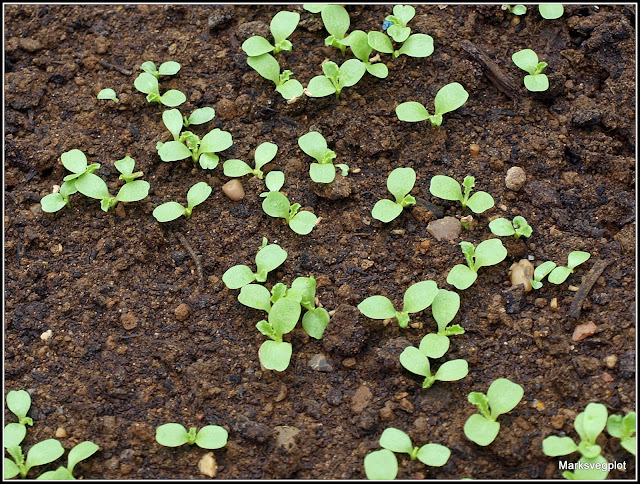Most types of chicory do best in coolish conditions (many of them are very hardy) and seem to prefer not to have to endure really hot sunshine. For this reason, I generally grow my Radicchio in the Autumn, sowing it in late June or early July, and planting it in its final position in late July or early August, for harvesting in October and November. With Endives, I do much the same, having tried unsuccessfully many times to grow Spring-sown ones. They always bolted, so I have given up on that approach. Here are the seedlings I sowed in June, currently about two inches tall. I'll be planting these out soon.
Earlier this year I grew some "Provencal Mix" (mixed lettuce, herbs and chicories) as a type of Baby Leaf Salad, and I extracted just a few (4, to be exact) chicory plants from the mix and have been growing them alongside my lettuces.
I'm hoping they will go on to be specially-strong plants, having had a lot longer than normal to develop. Of course this relies upon giving them the right conditions. The raised bed in which my salads are growing is comparatively shady, overshadowed as it is by a couple of trees, so the chicories seem to be managing OK, though I am still being careful to water them frequently.
This is how they look now:-
To be honest, I have no idea what type of chicories these four plants are. The one in the photo above looks more like a Treviso-type, which is typically tall and pointed, rather than the ball-headed type such as "Rossa di Verona" . On the other hand, it could also perhaps be "Pan di Zucchero" (Sugarloaf)
The other day I realised that I had loads of very old packs of Endive, Radicchio and Lettuce seeds - some dating back to 2005! I sowed a seed-tray of mixed varieties of each, sowing them very thickly on the understanding that it was unlikely that many of them would germinate. I have been pleasantly surprised, and quite a few of them have come up - though they are currently still tiny. Of course I have no idea which ones have come up and which haven't.
 |
| Endive seedlings |
I'll thin these out as they grow, retaining the strongest ones, and when they are a few inches tall I'll plant them in a raised bed. They are going to go in the bed currently holding onions and leeks. The leeks will be there for a few more months, but the onions are nearly ready for harvesting, so there should be enough room.
Hopefully, having made all these preparations I'll end up with "saladings" well into the Autumn. For now though, Lettuce rules the roost...
 |
| Lettuce "Yugoslavian Red" (immature) |





Interesting what you say about endive demand in England. Here in Croatia it is a very popular vegetable. You can find it on every market. And where did you find this 'Yugoslavian Red'lettuce? How odd, I never heard of it and the country is no more too.
ReplyDeleteHi Vesna; A friend in the Netherlands sent me the lettuce seeds. I believe they are ones that originated in the former Yugoslavia when her family emigrated because of the war.
DeleteI must ask....what's your standpoint on slugs?
ReplyDeleteI can't grow any lettuces at all as they get ravaged by slugs - I've tried a few things but it's an ongoing battle...wondering what you do?
Do they have anything like this in the UK? http://www.bonide.com/products/garden-naturals/view/903/slug-magic-pellets There are a few crops, lettuce included, that I always sprinkle a hefty dose of slug bait whenever I seed or transplant. But that is just one part of my three pronged approach to managing slugs.
DeleteIf you don't know where the slugs are living, plant some sacrificial marigolds. Or Dahlias. But the marigolds seem the most delectable. Go out in the morning when the dew is still out or just after an evening rainstorm. Salt any slugs you see and they will melt before your eyes. But be aware that the salt can also kill your plants. I only salt slugs that are on an indestructible surface.
And finally, you can kill them with beer. You just need a shallow pan (or lid) snuggled down into the mulch or soil, fill with beer. The slugs can't resist beer either and will drown in it.
1. Slug pellets
2. Salt
3. Beer
I use slug-pellets. Nothing else seems to work, and even the pellets are not 100% successful. Since most of my veg is grown either in netted raised beds or in containers, I assess the risk to hedgehogs etc as small. Having such a small garden I can only grow a few plants and the "sacrificial plants" approach doesn't work for me.
DeleteInteresting, thanks. I've managed to never use a single chemical in all my gardening so far, but I suspect I may have to break that rule next year and break out the slug pellets...!
DeleteOdd you should mention sacrificial plants though, this year I saw something strange along those lines - either slugs don't like kohlrabi or the radishes around them worked in that way - not a single slug touched the kohlrabi, yet the radishes were decimated!
I'm afraid that I'm not a fan of endive or raddichio but I must have eaten them as young leaves on mixed salad leaf packs.
ReplyDelete